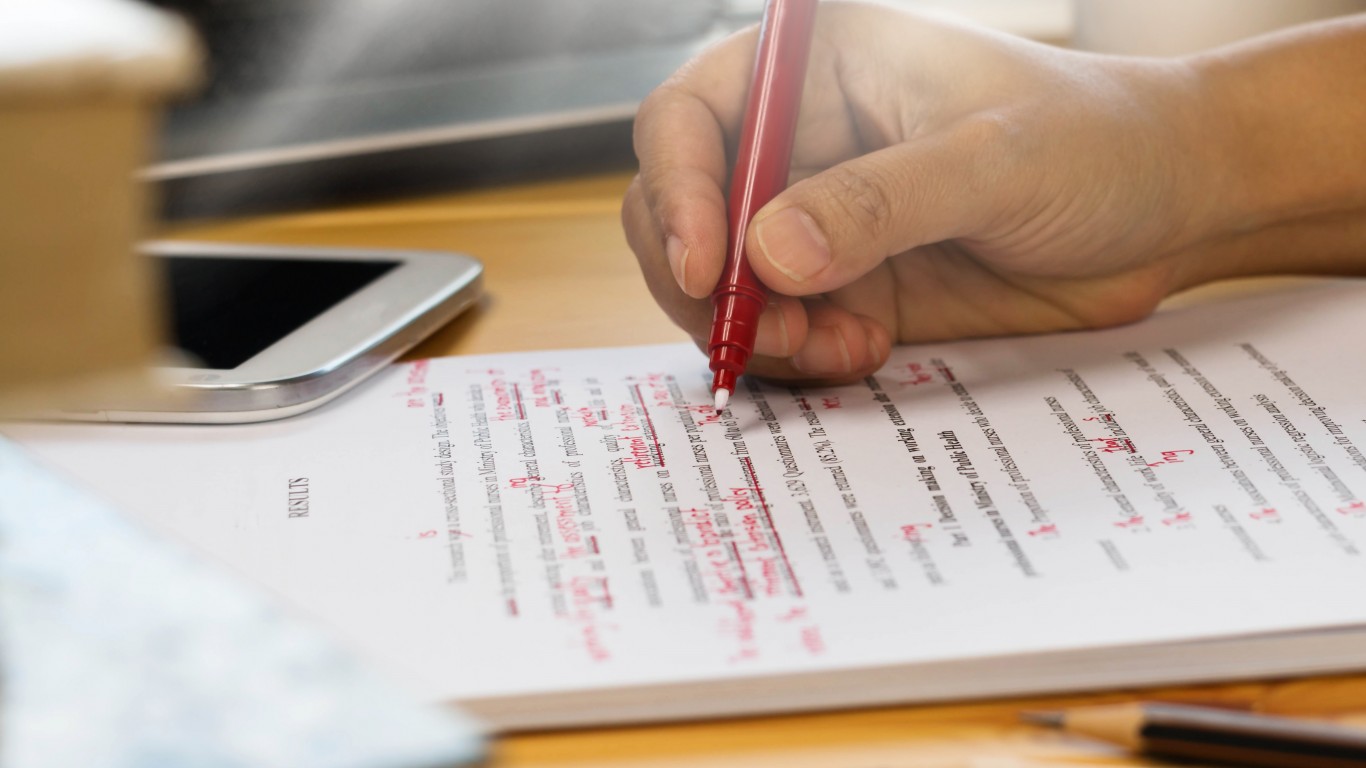
English usage, including grammar, spelling, and punctuation conventions, is full of contradictions, exceptions, and rules that we probably know implicitly but have probably never really thought about.
For those who grew up speaking English, many seemingly inexplicable rules are second nature. For those learning it as a second language, remembering a long list of irregular plurals (like mice or children) or inconsistent pronunciations (rough, though, bough) can be a daunting task. (Even native speakers have problems, of course. Here are 50 words people get wrong all the time.)
24/7 Tempo has compiled a list of 21 reasons why English is a difficult language by consulting several online language journals, style guides, and dictionaries, including Merriam-Webster.
Click here to see 21 English grammar rules that confuse everyone
The upshot is that some of the simplified “rules” we learned in elementary school weren’t actually rules, but rather rough guidelines and generalizations that have long lists of exceptions and contradictions. For example, the often quoted “i before e, except after c” rhyme may work for some words, but needs extensive clarification based on the sound that the “ie” combo makes.
For the purposes of academic and scientific writing, the rules may be more stringent; however acceptable usage changes over time, as style guides move toward accepting phrasing that was previously considered too informal. (Languages do evolve. Here are 36 old words we use today but with completely new meanings.)

1. It’s OK to start a sentence with a conjunction
Despite what your teacher may have told you, starting a sentence with “and” or “but” is acceptable according to most style guides. But it does look a bit informal.
[in-text-ad]

2. “Which” and “that” are not interchangeable
While they are both relative pronouns, “which” should be used in non-defining clauses with a comma, as in, “My car, which is in the shop today, has a flat tire.”
“That,” on the other hand, should only be used in comma-free clauses that are essential to the meaning of the sentence, as in, “The car that had a flat tire is in the shop today.”

3. Ablaut reduplication
Reduplication is the repetition of a word in a phrase like bye-bye or no-no. Ablaut reduplication changes the interior vowels of one or more of the almost-identical words in a phrase, as in tick-tock or lovey-dovey. Though we’re not usually aware of it, there is an order that the emphasized vowels should be placed in. In cases where there are two words, the first vowel should be “i” and the second is either “a” or “o,” as in hip-hop or chit chat. If there are three words, the order of the vowels has to be “i, a, o” as in tic-tac-toe. (Try reversing the order and see how it sounds.)

4. Parenthesis and punctuation
If a parenthetical phrase is at the end of a sentence, the terminal punctuation mark must be placed outside of the parentheses (like this).
(However, if the parenthetical is a full sentence and not part of another sentence, the punctuation mark is included within the parentheses.)
[in-text-ad-2]

5. Adjectives have a proper order
Here’s one we follow instinctively without questioning why: In most cases when multiple adjectives are used, their order is as follows: opinion, size, age, shape, color, origin, material, purpose – and then the noun they modify. They’re your “nice big old misshapen brown Italian leather hiking boots.” Try it out of order and see how strange it sounds.

6. “I before E except after C or when sounded as ‘a’ as in ‘neighbor’ or ‘weigh”’ is basically nonsense
There are dozens if not hundreds of exceptions to this rule, including weird, sovereign, glacier, seize, height, science, heist, leisure, foreign, vein, eight, caffeine⦠We could go on and on.
[in-text-ad]

7. The difference between less and fewer is easy to remember – except when it isn’t
“Less” is used for hypothetical quantities or singular mass nouns (less money, less time), while “fewer” is used for items you can actually quantify (fewer dollar bills, fewer hours). However, there are cases where “fewer” is technically correct but would sound jarring, so most authorities accept the use of “less” – like “25 words or less” in a contest or “10 items or less” at the supermarket.

8. Many irregular plurals don’t use an s
For those learning English, there is a long list of irregular plurals to memorize including feet, women, teeth, deer, mice, children, lice, and oxen.

9. The difference between may and might
Although they can sometimes be used interchangeably, “may” and “might” have different connotations. “May” signifies when there is a possibility, or when something could be factual. “Might” implies that something is hypothetical or uncertain.
[in-text-ad-2]

10. The difference between lay and lie
“Lay” needs an object, as in, “I’m going to lay this book on the table,” while “lie” doesn’t take an object, as in, “I’m going to lie down.” It gets very confusing in past tense however, as the past tense of “lie” is “lay,” as in, “He lay down early last night” – and the past tense of “lay” is “laid,” as in “I don’t remember where I laid the book.”

11. Compound subjects
When talking about two people at the same time, the verb must agree with the compound subject. Sometimes it’s straightforward, as in “Max and Stan are walking the dog.” But if there is an “or” or “nor” in the subject, the verb will agree with the most recent noun, as in “Max or Stan is walking the dog.”
[in-text-ad]

12.Coordinate vs cumulative adjectives
Cumulative adjectives – which are usually from different categories such as age and size – don’t get commas, while coordinate adjectives do. To determine if your adjectives are cumulative, try to either change the order of adjectives or add the word ‘and’ between them. If the meaning is not the same, then they’re cumulative adjectives, as in “a modern Japanese electric car.”

13. Split infinitives
An infinitive is a verb preceded by “to”, as in “to go” or “to teach.” While it is acceptable in speech and informal writing to split infinitives with adjectives, as in “it was hard to completely follow his logic,” it should be avoided in formal writing.

14.The difference between who and whom
“Who” describes the subject of a sentence, while “whom” is the object. If you can’t figure it out, substitute the “who/whom” pronoun with “he/him” or “she/her.” “Who” will correspond with “he/she,” while “whom” will correspond with “him/her.”
[in-text-ad-2]

15. The “kind of” rule
The “kind of” rule is why artists paint “still lifes” instead of “still lives,” and why the “Toronto Maple Leafs” hockey team are not the “Toronto Maple Leaves.” Because a still life is a kind of painting, rather than a kind of life, and the Maple Leaves are a sports team rather than a kind of leaf, their pluralization does not follow the regular rule for pluralizing the words “life” or “leaf.”

16. None can take a singular or plural verb
Because “none” is derived from “not one,” which is singular, it usually takes a singular verb, as in “none of the pizza is left.” Style guides, on the other hand, agree that none can have a plural verb in some situations, when the “nothing” that the word refers to is plural, as in, “I ordered three pairs of shoes, but none of them are here yet.”
[in-text-ad]

17. Compound possession
When there are two subjects in a possessive phrase, you must determine whether the two people possess the object together, or separately. For example, in the phrase “Kareem’s and Kumar’s houses are red,” Kareem and Kumar do not share ownership of their red houses. On the other hand, “Kareem and Kumar’s houses are red,” means that Kareem and Kumar share ownership of multiple red houses.

18. It’s OK to end a sentence with a preposition
While Latin grammar dictates otherwise, English grammar permits ending a sentence with a preposition. What kinds of grammar snobs have you been hanging out with?

19. Animacy hierarchy in possessives
Possessives, such as “Tina’s cat” are formed with reference to the animacy hierarchy, which basically moves in decreasing order of humanness, going from human to animal to inanimate object. The closer to a human that the possessor of the phrase is, the worse the ‘of’ construction sounds. This is why “the cat of Tina” sounds strange but “the hood of the car” sounds completely normal.
[in-text-ad-2]

20. The difference between among and, well, between
Grammar sticklers sometimes maintain that “between” can refer to no more than two things (“between noon and one,” “between Houston and Dallas”) while “among” is used for three or more things or for things that aren’t differentiated individually (“among the pine trees, oaks, and maples,” “among friends”). But “between” is perfectly correct for numerous items. You wouldn’t say “I couldn’t decide among chocolate, vanilla, and strawberry” or “The treaty among Italy, France, and England wasn’t signed.”

21. The difference between “me” and “I”
The simple distinction is that “I” is a subject, “me” is an object. If you’re tempted to say “My friend and me went to the movies,” try taking your friend out of the equation. Would you say “Me went to the movies?” Likewise, “John met my friend and I at the movies” is wrong – as you’d quickly realize if, again, you left your friend at home (“John met I at the movies???”) And how about “It’s me” vs “It is I?” The latter is correct, strictly speaking, but in practice both are acceptable – and “It is I” sounds stilted and pretentious in anything other than very formal circumstances.
The Average American Is Losing Their Savings Every Day (Sponsor)
If you’re like many Americans and keep your money ‘safe’ in a checking or savings account, think again. The average yield on a savings account is a paltry .4% today, and inflation is much higher. Checking accounts are even worse.
Every day you don’t move to a high-yield savings account that beats inflation, you lose more and more value.
But there is good news. To win qualified customers, some accounts are paying 9-10x this national average. That’s an incredible way to keep your money safe, and get paid at the same time. Our top pick for high yield savings accounts includes other one time cash bonuses, and is FDIC insured.
Click here to see how much more you could be earning on your savings today. It takes just a few minutes and your money could be working for you.
Thank you for reading! Have some feedback for us?
Contact the 24/7 Wall St. editorial team.
 24/7 Wall St.
24/7 Wall St.